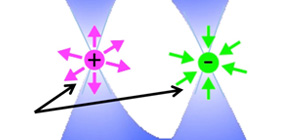
New topological materials, “Weyl semimetals,” discovered
Momentum toward the development of super-high-speed next-generation devices with low power consumption
A group of researchers led by Associate Professor SOUMA Seigo and Professor TAKAHASHI Takashi (Advanced Institute for Materials Research (AIMR), Tohoku University), Associate Professor SATO Takafumi (Graduate School of Science, Tohoku University), Professor OGUCHI Tamio (The Institute of Scientific and Industrial Research, Osaka University), and Professor ANDO Yoichi (University of Cologne, Germany) succeeded in discovering a new topological material, Weyl semimetal.
Dirac electrons in graphene travel quickly through the material, as if they were massless, have 10 times the mobility of silicon, and exhibit very high electrical and thermal conductivity. It is expected that the breaking of spin degeneracy in a certain type of semimetal produces Weyl particles in materials. These Weyl particles have topological properties: two particles with left- or right-handed chirality appear in pairs, and these two Weyl particles are massless unless they collide with each other. Right- or left-handed chirality is determined by whether the particle's spin is aligned with or against its direction of motion.
A theoretical proposal of a new kind of material containing these Weyl particles, called “Weyl semimetals,” was recently made, and the material synthesis and experimental verification of Weyl particles has been sought after. This joint group succeeded in growing high-quality large NbP crystals and examined the electronic states of NbP by using high-resolution angle-resolved photoemission spectroscopy (ARPES). Focusing on the crystal structure of NbP, this group examined the electronic status of Nb- and P-terminated surfaces, showing that the Fermi-arc state, which characterizes Weyl semimetals, was totally different on the surfaces of Nb and P, respectively. This group also found that the intersection of the two overlaid Fermi-arcs corresponded to the location of Weyl particles. From this, it was experimentally established that NbP was a new type of Weyl semimetal.
This group’s study showed that the Weyl particles, whose verification was long waited for, existed in actual solid material. Weyl particles have a very high electric and heat conductivity, so this group’s discovery will promote the development of ultra-high speed electronic devices featuring low power consumption.
Abstract
We have performed high-resolution angle-resolved photoemission spectroscopy (ARPES) on noncentrosymmetric Weyl semimetal candidate NbP, and determined the electronic states of both Nb- and P-terminated surfaces. We revealed a drastic difference in the Fermi-surface topology between two types of surfaces, whereas the Fermi arcs on both surfaces are likely terminated at the surface projection of the same bulk Weyl nodes. A comparison of the ARPES data with our first-principles band calculations suggests a notable difference in the electronic structure at the Nb-terminated surface between theory and experiment. The present result opens a platform for realizing exotic quantum phenomena arising from the unusual surface properties of Weyl semimetals.

Figure 1

Figure 2

Figure 3

Figure 4
To learn more about this research, please view the full research report entitled “Direct observation of nonequivalent Fermi-arc states of opposite surfaces in the noncentrosymmetric Weyl semimetal NbP” at this page of the Physical Review website.
Related link
